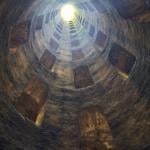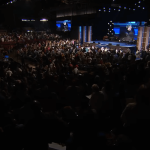In the sermon this morning, we will be looking at one particular kind of animal offering from the Old Testament, and looking at the system of offerings in general. As we will see, these offerings recapitulated in ritual form the major events of Israel?s history, particularly the Passover, exodus, and covenant-making at Sinai. But behind that there is another pattern that is ritually embodied in the offerings of the Levitical law. That is the pattern of creation.
According to Genesis 1, Yahweh works in basically the same way each day of the creation week. On each day, He takes hold of the creation, tears it in pieces, puts the pieces back together in a new way, assigns new names, and then declares it good. He takes hold of the dark and formless world of the first day, and divides between light and darkness, arranges light and darkness in an alternative sequence, and gives names ?EHe calls the light day and the darkness night. Then he declares that this is good. On the third day, He takes hold of the waters on the earth, tears the seas in two so that the dry land appears, and calls the dry land earth and the waters He calls seas. And then He declares it good. And so on through the remaining days.
By doing this, Yahweh is moving the world from glory to glory. From the first moment of its existence, the world manifests something of the Creator?s power and glory. But day after day through the creation week, He is making it more glorious. A lighted creation is better than a dark one; a formed creation is better than a formless one; and a creation that teems with life is greater than an empty container.
When God sets about to recreate the world during the course of history, He works in the same way. He takes hold of the tabernacle at Shiloh, tears it in pieces, puts the pieces in various places ?Ea bit in Gibeon, another piece in Nob, the ark in Jerusalem. Finally He puts them back together in a new way, in the temple. Centuries later, He takes the temple apart, sending the furniture of the temple into exile in Babylon, but after 70 years of exile He brings the furnishings of the temple back and makes a new house.
This same pattern is recapitulated in the rituals of animal offerings in the Torah. Each sacrifice involves certain basic actions. The worship leans his hand on the animal, designating it as his representative and setting it apart for priestly duties. He divides the animal, separating blood from flesh and separating one part of the flesh from other parts. At the end of the rite, the animal is turned to smoke when it is placed in the fire on the altar. The animal is transfigured into a new condition, so that it can ascend to Yahweh, doing what the worshiper cannot do. These actions of the worshiper point to God?s actions ON the worshiper: For the animal that is torn and remade represents the worshiper. Ultimately, Yahweh is the one who tears and recreates through sacrifice.
Sacrifice, in short, has to do with new creation. Every new covenant involves a new creation, and every time an Israelite came to offer an animal on the altar, Yahweh makes him new. And our worship is sacrificial in the same sense. Every time we come to worship, God works with us to make a new creation, to transform us from glory to glory, both as individuals and as a church. Each time we enter God?s presence in worship, He tears us by His word, gives us a new name, and transforms us from glory to glory.
Of course, going through the motions of worship is not acceptable to God, and it never has been. Worship is not a machine for recreation that works whether or not we trust and love Him. Worship recreates when, in faith, we submit to the knife, allow God to tear us apart, trusting that He will put us back together.











